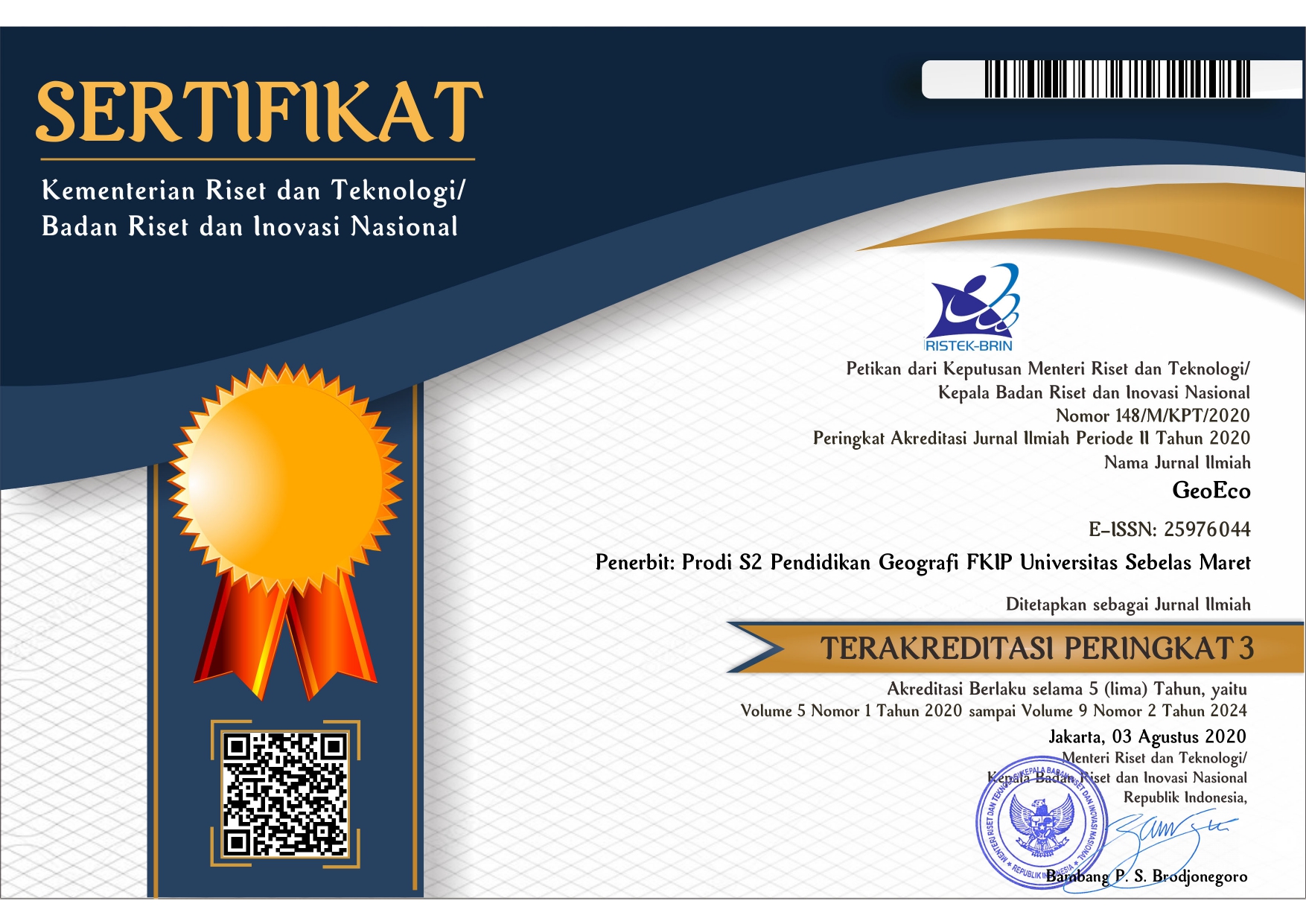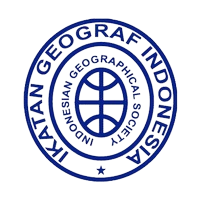RURAL REVITALIZATION THROUGH TOURISM: SPATIAL ANALYSIS OF NOHAKU ACCOMMODATION DISTRIBUTION AND PRICING IN YAMAGUCHI PREFECTURE, JAPAN
Abstract
Keywords
Full Text:
PDFReferences
Akhtari, M. (2021). Proximity to Hotels and Airbnb Home Sharing Accommodations. In M. Ferrante, O. Fritz, & Ö. Öner (Eds.), Regional Science Perspectives on Tourism and Hospitality (pp. 165–180). Springer International Publishing. https://doi.org/10.1007/978-3-030-61274-0_9
Asamizu, M., Fred R, S., & Abhik, C. (2015). Rural tourism for local revitalization in Yamaguchi Prefecture. Yamaguchi Journal of Economics, 63(6), 499–515.
Baddeley, A., Rubak, E., & Turner, R. (2015). Spatial Point Patterns: Methodology and Applications with R. Chapman and Hall/CRC. https://doi.org/10.1201/b19708
Benítez-Aurioles, B. (2022). The exhaustion of the herding effect in peer-to-peer accommodation. Tourism Economics, 28(1), 27–43. https://doi.org/10.1177/1354816620946537
Brunsdon, C., & Comber, L. (2015). An introduction to R for spatial analysis & mapping. https://www.semanticscholar.org/paper/An-introduction-to-R-for-spatial-analysis-%26-mapping-Brunsdon-Comber/1ad5a568f7f7c5987854e7623c312c90ac31da4e
Calero, C., & Turner, L., W. (2020). Regional economic development and tourism: A literature review to highlight future directions for regional tourism research. https://journals.sagepub.com/doi/full/10.1177/1354816619881244
Chakraborty, A., & Asamizu, M. (2014). Revitalizing Japan’s Mountainous Areas through Green Tourism: A Human Geographical Perspective. Issues in Social Science, 2(1), Article 1. https://doi.org/10.5296/iss.v2i1.5340
Daigaku, H., & Nohguchi, R. (2019). A study on the Genealogy and Current Status of Farm Stays in Japan. Journal of Rural Planning Studies, 38(Special_Issue), 298–306. https://doi.org/10.2750/arp.38.298
Ferrante, M., Fritz, O., & Öner, Ö. (Eds.). (2021). Regional Science Perspectives on Tourism and Hospitality. Springer International Publishing. https://doi.org/10.1007/978-3-030-61274-0
Gao, J., & Wu, B. (2017). Revitalizing traditional villages through rural tourism: A case study of Yuanjia Village, Shaanxi Province, China. Tourism Management, 63, 223–233. https://doi.org/10.1016/j.tourman.2017.04.003
Ikeji, T., & Nagai, H. (2021). Residents’ Attitudes Towards Peer-to-Peer Accommodations in Japan: Exploring Hidden Influences from Intergroup Biases. Tourism Planning & Development, 18(5), 491–509. https://doi.org/10.1080/21568316.2020.1807400
Janjua, Z. ul A., Krishnapillai, G., & Rahman, M. (2021). A Systematic Literature Review of Rural Homestays and Sustainability in Tourism. SAGE Open, 11(2), 21582440211007117. https://doi.org/10.1177/21582440211007117
Ji, N. Y. (2024). Return to the countryside: An ethnographic study of young urbanites in Japan’s shrinking regions. Journal of Rural Studies, 107, 103254. https://doi.org/10.1016/j.jrurstud.2024.103254
KAWAMURA, A., HOSHINO, S., SHIMIZU, N., & ONITSUKA, K. (2017). Study on Development Process of Organized Farm-inn District and Promblems of its Continuation-Case study of “Shunran-no-sato” in Noto Town, Ishikawa Prefecture-. The Association of Rural Planning, 36(Special_Issue), 229–234. https://doi.org/10.2750/arp.36.229
Khartishvili, L., Muhar, A., Dax, T., & Khelashvili, I. (2019). Rural Tourism in Georgia in Transition: Challenges for Regional Sustainability. Sustainability, 11(2), Article 2. https://doi.org/10.3390/su11020410
Kopczewska, K. (2020). Applied Spatial Statistics and Econometrics: Data Analysis in R. Routledge. https://doi.org/10.4324/9781003033219
Lane, B. (1994). What is rural tourism? Journal of Sustainable Tourism, 2(1–2), 7–21. https://doi.org/10.1080/09669589409510680
Lane, B., & Kastenholz, E. (2015). Rural tourism: The evolution of practice and research approaches – towards a new generation concept? Journal of Sustainable Tourism, 23(8–9), 1133–1156. https://doi.org/10.1080/09669582.2015.1083997
Louis-Frédéric. (2002). Japan Encyclopedia. Harvard University Press.
Milán-García, J., Uribe-Toril, J., Ruiz-Real, J. L., & de Pablo Valenciano, J. (2019). Sustainable Local Development: An Overview of the State of Knowledge. Resources, 8(1), Article 1. https://doi.org/10.3390/resources8010031
Moraga, P. (2023). Spatial Statistics for Data Science: Theory and Practice with R. Chapman and Hall/CRC. https://doi.org/10.1201/9781032641522
Muryani, C., Santoso, S., & Prihadi, S. (2019). Analysis the distribution and potential of tourism object in Ngargoyoso District, Karanganyar Regency. GeoEco, 5(1), 73–81.
Ohashi, M. (2002). Possibilities for and Limitations of Rural Tourism in Disadvantaged Areas of Japan. Geographical Review of Japan, 75(3), 139–153. https://doi.org/10.4157/grj.75.139
Ohe, Y. (2008). Characteristics and issues of rural tourism in Japan. 305–316. https://doi.org/10.2495/ST080301
Ohe, Y. (2016). Community-based rural tourism in super-ageing Japan: Challenges and evolution. Anais Brasileiros de Estudos Turísticos: ABET, 6(1), 28–41.
Pina, I. P. A., & Delfa, M. T. D. (2005). Rural tourism demand by type of accommodation. Tourism Management, 26(6), 951–959. https://doi.org/10.1016/j.tourman.2004.06.013
Publications: MAFF. (n.d.). Retrieved June 15, 2024, from https://www.maff.go.jp/e/data/publish/#Annual
Rosalina, P. D., Dupre, K., & Wang, Y. (2021). Rural tourism: A systematic literature review on definitions and challenges. Journal of Hospitality and Tourism Management, 47, 134–149. https://doi.org/10.1016/j.jhtm.2021.03.001
Ruiz-Real, J. L., Uribe-Toril, J., de Pablo Valenciano, J., & Gázquez-Abad, J. C. (2022). Rural tourism and development: Evolution in Scientific Literature and Trends. Journal of Hospitality & Tourism Research, 46(7), 1322–1346. https://doi.org/10.1177/1096348020926538
Rustiadi, E., Saizen, I., Pravitasari, A., Wulandari, S., Mulya, S., & Rosandi, V. (2022). AsianRuralFuture2030.
Sánchez-Martín, J. M., Hernández-Carretero, A. M., Rengifo-Gallego, J. I., García-Berzosa, M. J., & Martín-Delgado, L. M. (2023). Modeling the Potential for Rural Tourism Development via GWR and MGWR in the Context of the Analysis of the Rural Lodging Supply in Extremadura, Spain. Systems, 11(5), 236. https://doi.org/10.3390/systems11050236
Sharpley, R. (2002). Rural tourism and the challenge of tourism diversification: The case of Cyprus. Tourism Management, 23(3), 233–244. https://doi.org/10.1016/S0261-5177(01)00078-4
Sugimoto, K., & Kikuchi, T. (2014). Regional Characteristics of the Distribution of Touirsm Resources in Japan. Journal of Geography (Chigaku Zasshi), 123(1), 1–24. https://doi.org/10.5026/jgeography.123.1
Syngellakis, S., & Rodriguez, P. D. (2022). Sustainable Tourism X. WIT Press.
Times, T. N. Y. (2024, January 9). 52 Places to Go in 2024. The New York Times. https://www.nytimes.com/interactive/2024/travel/places-to-travel-destinations-2024.html
Tussyadiah, I. P., & Pesonen, J. (2016). Impacts of Peer-to-Peer Accommodation Use on Travel Patterns. Journal of Travel Research, 55(8), 1022–1040. https://doi.org/10.1177/0047287515608505
Volgger, M., Taplin, R., & Pforr, C. (2019). The evolution of ‘Airbnb-tourism’: Demand-side dynamics around international use of peer-to-peer accommodation in Australia. Annals of Tourism Research, 75, 322–337. https://doi.org/10.1016/j.annals.2019.02.007
Walford, N. (2001). Patterns of development in tourist accommodation enterprises on farms in England and Wales. Applied Geography, 21(4), 331–345. https://doi.org/10.1016/S0143-6228(01)00010-8
Xie, Y., Meng, X., Cenci, J., & Zhang, J. (2022). Spatial Pattern and Formation Mechanism of Rural Tourism Resources in China: Evidence from 1470 National Leisure Villages. ISPRS International Journal of Geo-Information, 11(8), 455. https://doi.org/10.3390/ijgi11080455
Yuanyuan,Wang, Hairon,Sato, & Yue. (2021). Proposal and Evaluation of an Accommodation Ranking Method based on Relationship Analysis between Tourist Spots and Accommodations. Jornal of the Japan Personal Computer Application Technology Society, 16(2), 1–11. https://doi.org/10.24663/jjpcats.16.2_1
Żakowska, S., & Podhorodecka, K. (2018). The correlation between the distribution of tourism assets and the location of tourist accommodation in Łódź Province. Turyzm/Tourism, 28(2), 73–84. https://doi.org/10.2478/tour-2018-0017
Zhang, T., & Li, L. (2021). Research on temporal and spatial variations in the degree of coupling coordination of tourism–urbanization–ecological environment: A case study of Heilongjiang, China. Environment, Development and Sustainability, 23(6), 8474–8491. https://doi.org/10.1007/s10668-020-00976-8
Zhang, Y., Li, W., Li, Z., Yang, M., Zhai, F., Li, Z., Yao, H., & Li, H. (2022). Spatial Distribution Characteristics and Influencing Factors of Key Rural Tourism Villages in China. Sustainability, 14(21), 1–26.
Zhao, H., Zheng, J., Ma, S., Zhao, L., Xu, P., & Li, J. (2023). Spatial distribution and influencing factors analysis of national key rural tourism villages in the Yangtze River Delta region based on geographically weighted regression. PloS One, 18(11), e0291614. https://doi.org/10.1371/journal.pone.0291614
Refbacks
- There are currently no refbacks.












.png)

